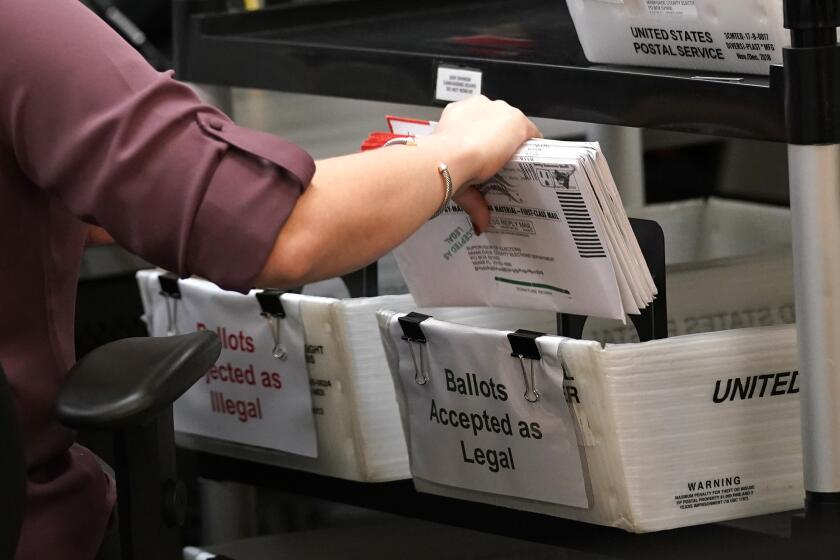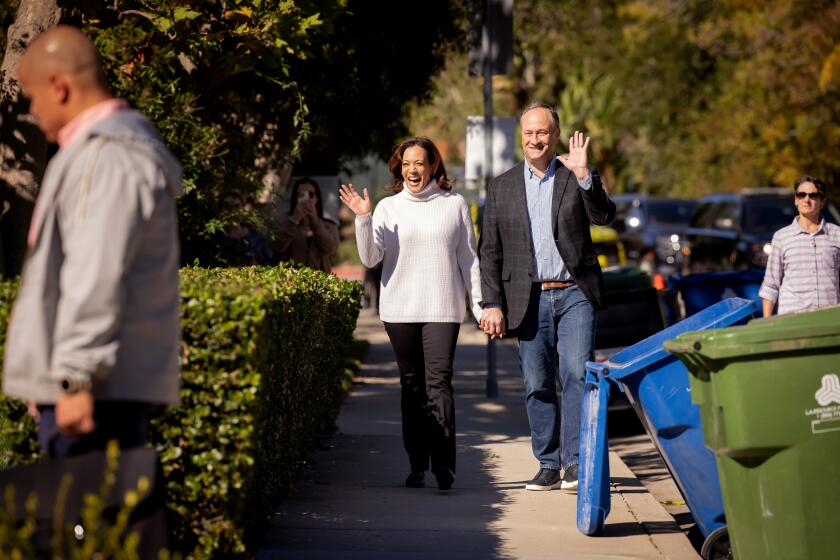No One Sits on Fence in Barrier Dispute
There sat the yellow Ryder truck, snuggled up to the golden-domed state Capitol, parked, locked, deserted and highly suspicious.
Out went the security alarm. Uniformed officers cautiously approached. They couldn’t identify the truck’s purpose and summoned a bomb-sniffing dog. No explosives. False alarm.
The rental truck, similar to the one that carried a bomb that blew up the Oklahoma City federal building, killing 168 people, turned out to be part of an approved Earth Day celebration this spring at the Capitol.
The incident escaped public attention, but officials say it demonstrated the need for improved security at the hub of California government.
And now it appears likely that state leaders will approve the construction of a low fence that would encircle the historic building and six square blocks. The intent is to stop unauthorized vehicles from coming onto the Capitol grounds.
But the proposed fence, which would stand about 4 feet high and be modeled after an ornate iron bar and granite barrier that ringed the Capitol for more than half a century, is kicking up controversy.
Critics note that such a fence may not stop an Oklahoma City-style terrorist. Preservationists fear that a new fence would not be faithful to the original. And some lawmakers warn that it could chill the traditional openness that Californians expect of their Capitol.
Senate President Pro Tem Bill Lockyer (D-Hayward) agrees that the fence would not stop a determined bomber. But he says it would impose a degree of stricter control over access to the Capitol and its surrounding verdant park, popular with state workers and tourists.
“It doesn’t prevent someone who wants to smuggle in a big bomb at night,” Lockyer said.
But a fence, coupled with tighter permit procedures on vehicle access, could deter what Lockyer calls occasional “casual security problems” such as this spring’s Ryder truck affair.
He said such disruptive incidents “mostly waste personnel time, cause panic, produce evacuations and result in calls to the bomb squad.”
The proposed fence would be the centerpiece of a semi-secret $3.46-million project to upgrade security at the Capitol. Other improvements would include reconfiguring driveways to the building’s basement garage for VIPs and coating office windows with a protective material that minimizes glass shards in case of an explosion.
Final approval of the fence design is expected soon, and construction is planned to start next summer, said Senate Sergeant-at-Arms Tony Beard.
The project was written into last year’s state budget by Gov. Pete Wilson and legislative leaders without public announcement. It was tucked away in an obscure paragraph of spending plans for the California Highway Patrol.
The tiny item contained no mention of a Capitol fence and did not specifically identify other “security upgrades.” State police officials, who usually are eager to trumpet their public works projects, still decline to discuss the fence publicly.
Mike Brown, the CHP chief in charge of Capitol security, refused to confirm that a fence is even contemplated. “It would be premature at this point to comment on the subject of a fence, if there were a fence,” he said.
Lockyer, one of those who quietly approved the fence expenditure, said in a recent interview that Capitol security issues took on new intensity after the 1995 Oklahoma City bombing.
The bombing refocused attention on ensuring that the California Capitol is safe for top officials, their staffs and citizens, Lockyer said.
But he said decision makers must try to accommodate the sometimes conflicting demands of protecting the openness of the building, keeping faith with the historical surroundings, providing security and accomplishing them at a reasonable price.
“This is the people’s building, and it should feel like part of the people, not an armed camp,” Lockyer said.
He said tighter controls on access, particularly by cars and trucks during demonstrations, would give officers a better fix on who belongs and who does not.
The fence would continue to allow pedestrian and vehicle traffic at all walkways and driveways, but would seal off the current open access to Capitol Park from the street, the Senate’s Beard said.
Sidewalk and driveway entrances would be barricaded by balustrades that could be removed for delivery trucks and emergency vehicles.
The fence would be modeled after an 1883 version that was anchored by at least eight massive domed granite pillars, some of which were relocated to the city of Folsom when the fence was torn down in 1949. Old documents list the original cost of building the fence at $15,000 and disclose that blocks for the granite foundation came from a quarry at Folsom Prison.
Beard said it is undecided whether the original pillars might be reclaimed for the new fence but ruled out trying to replicate the other costly historic decorations. For instance, spear-like tips on the metal bars will not be allowed because they could endanger visitors and potentially “be used as weapons,” he said.
Beard said options to a fence were considered and discarded. One vehicle barrier would have involved arranging large blocks of granite in a sweeping formation that resembled tombstones.
But some preservation activists and Sacramento historical officials are steamed about the fence proposal. They complain that they were left out of the state’s decision-making process, were surprised to only recently learn of the fence and still haven’t been fully consulted.
One critic, Assemblywoman Deborah Ortiz (D-Sacramento), challenged both the wisdom of constructing a fence as a security enhancement and the haste to proceed without seeking local points of view. “It’s a bit unnecessary,” she said of the fence.
Raymond Girvigian of South Pasadena, chairman of the Historic State Capitol Commission, which supervised the successful restoration of the Capitol in the 1970s and ‘80s, said he believes security goals can be accomplished but that any fence “must be historically correct.”
Kathleen Green, a Sacramento preservation activist and member of the state commission, insisted that re-creating the original fence is a higher priority than the extra security a modern fence would provide. “They either put the original back, or we are going to have some real arguments here.”
More to Read
Get the L.A. Times Politics newsletter
Deeply reported insights into legislation, politics and policy from Sacramento, Washington and beyond. In your inbox three times per week.
You may occasionally receive promotional content from the Los Angeles Times.










